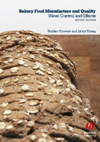Some types of bakery equipment bring multiple functions to streamline operations. Such is the case with Rapidojet, a revolutionary hydration and mixing technology offered by Bakery Concepts International, Enola, PA. We caught up with Ken Schwenger, president, to learn more about what this technology offers to today’s snack producers and bakers.
Douglas J. Peckenpaugh: What were the origins of Rapidojet?
Ken Schwenger: About 15 years ago, the German inventor, Dr. Bernhard Noll, discovered a new way for a single machine to instantly hydrate or mix any dry ingredient with any combination of liquids at any hydration level, from a 2 percent hydrocolloid solution to a 65 percent hydrated flour and water biga.
DJP: What are the fundamental basics of the Rapidojet technology?
KS: Instead of a hook, bar, whisk or other metal tool to force drys and liquids together, our patented use of high-pressure liquid addition to drys in a short, vertical pipe (our patent pending “mixing chamber”) instantly binds drys and liquids at any hydration level. This more-homogenous bond demands a higher hydration level to see the same level of “dough feel,” rheology and machinability.
DJP: How does this help improve the dough mixing process?
KS: Our patented use of high pressure instantly develops gluten structure and creates a homogeneous dough. Minors and micros can then be simply “folded” into the dough giving a mix time reduction of up to 85 percent. Ice, glycol, yeast and dough conditioner usage are reduced or eliminated, because Rapidojet doesn’t create the same level of abuse and heat from friction. Rapidojet can also be used as a continuous mixer for dough when minors and micros are pre-blended with the ingredient water. At only about 1.5 kilowatt hour per ton of output, this represents an energy savings of more than 80 percent vs. a traditional mixer.
DJP: How do these processes then help improve the quality of finished snack and bakery products?
KS: Bread dough, to achieve the same level of “dough feel” and machinability, normally requires about 8 percent higher hydration because the water is much more fully bound via Rapidojet. Thus, freezer burn is reduced and normal staling due to starch retrogradation is substantially slowed. Dough “tail out” has been seen to be substantially reduced. This is because the ideal hydration level is achieved instantly.
Dough tail out is a huge concern for all wholesale producers. “Cripples” and other scrap account for unwanted lost production volumes. Our customers have found that this is caused by improper hydration prior to make-up. Rapidojet’s patented use of high-pressure liquid addition instantly penetrates the natural surface tension barrier of dry ingredients so that the optimal hydration level is achieved. So, rounding time, speed and pressure do not need to be changed as dough runs down the make-up line. Final product consistency is greatly improved.
DJP: In what other ways does the technology help improve overall bakery throughput and production efficiency?
KS: For liquid sponge, our use of high pressure introduces much more oxygen to the ingredient water. Thus, the same flavor and aroma are achieved with 25 percent less fermentation time. Plus, about 10 percent more water must be used to achieve the same sponge consistency. Throughput is greatly increased when mix times in legacy mixers are reduced by 85 percent. When pre-hydrating all ingredient flour, total yield is increased by approximately 8 percent.
ROI can be far shorter than one year. Based on the previously stated benefits and output, ROI can even be as short as just a few months.
To feed the Rapidojet RJ5100 system, a reliable ingredient automation system will be required. The RJ1000 machine is normally fed manually because its output capacity runs from about 600 kilograms per hour to 1,250 kilograms per hour, based on the amount of pressure used and the hydration level desired. When hydrating with only water, a very simple direct connection to the Rapidojet high pressure pump can be made from the incoming water source. Rapidojet utilizes an IFM Efector flow meter to achieve accuracy of within 0.5 percent.
DJP: What specific snack and bakery products have shown proven benefits from implementation of Rapidojet technology?
KS: One customer eliminated their mixers and bowls for masa mixing and installed Rapidojet above their masa hog for continuous mixing of tortilla chips. Worker safety and sanitation are greatly improved with the elimination of mixers and bowls. Product consistency, output, worker safety and sanitation have been greatly improved, while mixing energy has been reduced by more than 80 percent and labor cut substantially.
Bran for whole wheat bread is instantly hydrated at 250 percent instead of the normal three-hour soaking time, resulting in 80 percent hydration. This results in increased total yield, higher loaf volume, longer shelf life, more-consistent product, better eating quality and a mix time reduction of about 10 percent. Now there is no need to allocate valuable floor space for the normal 3-hour soaking time, which only results in a hydration level of about 80 percent.
Vital wheat gluten usage, when pre-hydrated at 400 percent and then added to the legacy mixer, is reduced by 20 percent.
Continuous mixing of gluten-free batters with delivery to the make-up line is easily done.
Whole-grain blends are instantly cleaned and hydrated prior to mixing, resulting in higher dough yield, longer shelf life, better consistency and increased loaf volume.
The next time you fly Air France, the baguette you eat will have been made with Rapidojet. The bakery attached a heat exchanger to Rapidojet, and we are shooting super-heated water into the free-falling flour. The result is a gelatinized paste used as a 30 percent sponge prior to final mixing. This gelatinization process has substantially slowed the normal starch retrogradation process of staling. The shelf life of a fully baked baguette, held in a paper bag, has gone from one day to more than three days, with an excellent crispy crust and a soft crumb.
Imagine Rapidojet run as a continuous mixer for breads and rolls, at only about 1.5 kilowatt hour per ton of output with no ice or glycol needed and getting 8 percent higher hydration level, using 25 percent less yeast and 25 percent less dough conditioner, and with almost no labor input. Doughs and batters are pumped via a sanitary, clean-in-place (CIP) pump directly to the make-up line. The patent pending Rapidojet mixing chamber replaces the legacy mixer and bowls. It is removed from Rapidojet in less than five seconds with no tools and is cleaned in the dishwasher.
DJP: Where around the world has Rapidojet been implemented?
KS: Rapidojet machines can be found in almost all European countries, as well as Russia, Australia, the U.S., and South and Central America. The world’s largest potato processor has been running Rapidojet for at least 6 years for continuous mashed potato production.
DJP: What’s next for this technology?
KS: Given the ability of Rapidojet to perform at all hydration levels, the potential applications for soups, juices, jellies, jams, snack foods, continuous dough mixing and more is yet to be discovered. Our seminars and studies at AIB International and the Wheat Marketing Center have shown that the benefits to flour milling and the brewing industries will potentially eclipse those for traditional mixing.
A shorter version of this interview was published in the August print issue of Snack Food & Wholesale Bakery.













